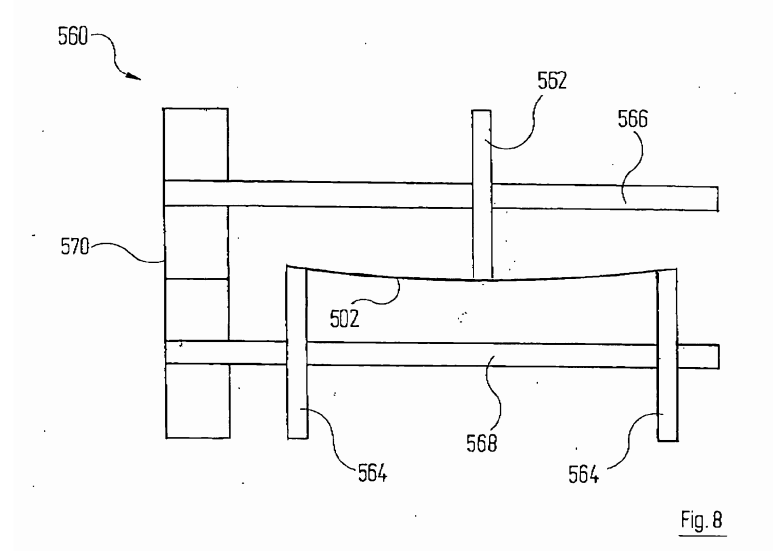The application relates to a “Device for reading in particular flexible imaging plates”.
The application is a divisional application from EP 06777020/EP 1 929 763
Brief outline of the case
The application was refused as claim 1 of the sole request did not fulfil the requirements of Art 123(2) and 76(1) and that the subject-matter of claim 1 was not new compared to the disclosure of document D14.
With the statement of grounds of appeal, the applicant filed claims according to a MR and AR 1 and 2.
In its communication under Art 15(1) RPBA20 the board raised a number of objections, inter alia, under Art 84, 76(1) and 123(2).
Further AR 3-5 were filed in reply.
All requests in appeal were actually relating to fig 8 of the application/patent, which is also to be found in the parent application/patent..
The board decided that the MR as well as AR 1 and 2 were infringing Art 84.
The board decided that the AR 3-5 were infringing Art 76(1).
The refusal was confirmed.
The argumentation on added-matter
The board’s position
The characteristic portion of claim 1 of AR 3 reads:
“the at least one drive means (560) is designed in such a way that a imaging plate without a carrier (502) fed to the transport device is brought into the cylindrical shape of the reading area by the drive means (560) during transport in the transport direction, the transport direction and the longitudinal axis of the cylinder being parallel.”
The board considered that in claim 1 of AR3, the drive means which brings the supplied imaging plate into the cylindrical shape of the reading area is not further specified, and hence was infringing Art 76(1).
Fig 8 and page 44, line 24 to page 46, line 3 of the parent application as originally filed disclose only a specific film drive means comprising a single pressure wheel (562) at the top and two drive wheels (564) at the bottom on a common horizontal axis, which are specific to each other to achieve the desired curvature of the imaging plate (502).

The earlier application as originally filed only describes deformations using a specific wheel arrangement. There is no indication in the earlier application as originally filed that deformation can be achieved using a different wheel arrangement, a different mechanical arrangement or even a non-mechanical method.
A generalisation to deformation methods based on other wheel arrangements, other mechanical arrangements or even non-mechanical methods is not immediately and unambiguously apparent to a skilled person reading the earlier application as originally filed.
For this reason, the subject-matter of claim 1 of AR 3 is a generalisation which goes beyond the content of the earlier application as originally filed.
This argumentation relating to AR 4 and 5 was as “convincing” for the board as the previous one.
The skilled person had to deviate from the solution for a symmetrical bend disclosed in the earlier application without any indication or hint for such a change in the earlier application as originally filed.
The applicant’s position
For claim 1 of AR 3, the applicant referred to Figure 8 of the earlier application as originally filed and brought forward the skilled person’s ability to abstract. The applicant argued that the skilled person would be able to infer from the specific wheel arrangement in Figure 8 a general drive means that would bring the supplied imaging plate into the cylindrical shape of the reading area.
A similar argumentation was brought forward with respect to AR 4 and 5. It was left to the skilled person’s ability to abstract which would immediately and unambiguously recognise that a different relative height of the drive wheels could be compensated for by the two drive wheels being at a different distance from the centre point formed by the pressure wheel. For this reason, the skilled person would immediately and unambiguously recognise that a symmetrical bend could be achieved despite the different relative heights of the drive wheels.
As said above the board neither agreed nor was convinced by the argumentation.
Comments
I have been in patents for quite a number of years, but it is the first time that in order to justify an undue generalisation an applicant appeals to the skilled person’s ability to abstract.
One had to dare coming up with such a justification. It has now happened.
This suggestion was made in relation with Art 76(1) but applies mutatis mutandis to Art 123(2).
https://www.epo.org/law-practice/case-law-appeals/recent/t172647du1.html
Comments
2 replies on “T 2647/17 – An interesting argumentation in order to justify an undue generalisation”
I am intrigued, and so must read the Decision in full. First reaction though is that anything is welcome, which would help me to understand what is the mental process of “deriving” useful stuff from the text and drawings of a document. I see here that the petitioner used the word “recognise”. I wonder, is the mental step of “recognising” the same step as, or different from, the step of “deriving”?
Dear Max Drei,
From a semantic point of view there might be a difference between “recognising” and “deriving”.
From a practical point of view I see none.
There are no pointers or teaching in the parent application in the direction claimed in the divisional.
It is not infrequent to file a divisional with a broader scope of protection than the parent.
It does however need some “flesh” around the “skeleton”.
It might even be obvious that other means can be used, but this is not the applicable criterion.